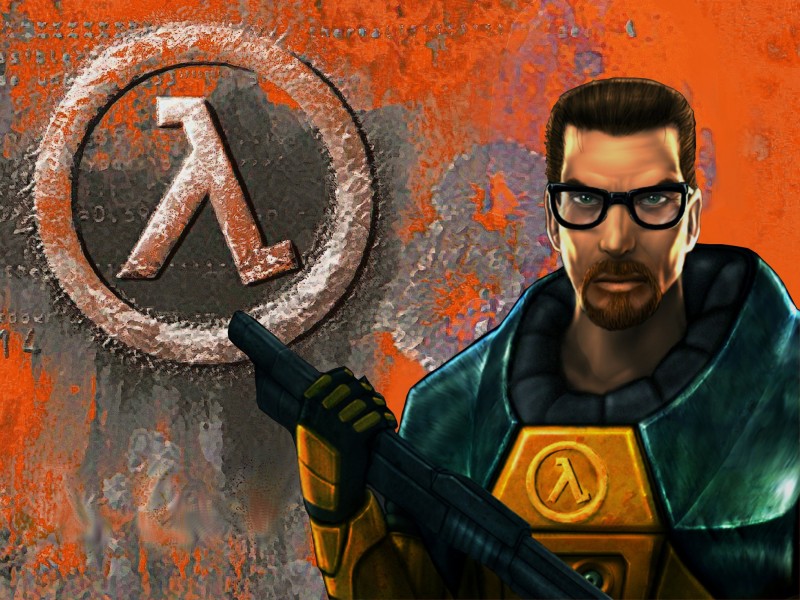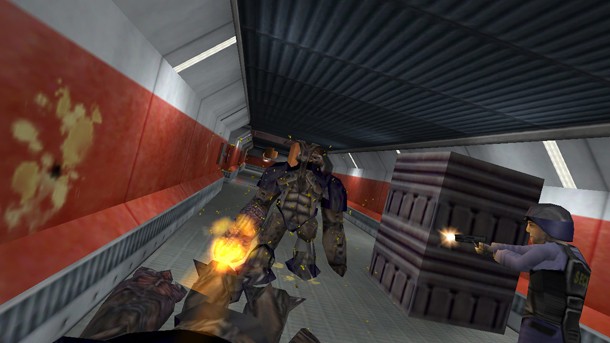The Greats: Half-Life (#2)

Hello, Javy Gwaltney here, Associate Editor for Game Informer. I currently putting together a series of deep dives into my ten favorite games of all time. You can read all about the origins, as well as the beginning of the series, here.
This week we’re going to be talking about my #2 pick: Half-Life. Feel free to leave comments below and thanks for reading. Be sure to come back next week on Wednesday at noon CST for #1
Half-Life changed things forever. That's a thing you can say about a handful of titles, but Half-Life both shifted the gaming landscape in number of ways and helped me define as a young person what it was that I was looking for in video games. It turned out I wanted to see how games could tell stories in interesting ways that were unique to the medium.
Half-Life wasn't the first first-person shooter that cast you as someone caught up in a deadly situation filled with monsters and aliens: DOOM and Quake had come years before, after all. However, from the get-go Half-Life uses the interactivity of games to take that very generic story and do something interesting with it. The lengthy intro of the game, following scientist Gordon Freeman as he commutes to work, still feels bold all these years later and manages to capture the game's aesthetic: a fine balance struck between zaniness of its sci-fi leanings and the realism of its hero and violence.

Gordon is not the DOOM Marine. He's not Marcus Fenix. He's a dorky scientist who finds himself way in over his head after a science experiment goes wrong, teleporting an army of aliens to Earth who promptly start murdering everyone. Oh, and the government shows up at one point and deploys troops who shoot people instead of rescuing them. It's all very chaotic and violent and the context of Gordon, even if he never speaks, as this everyman refigured the run and gun stories of DOOM and other first-person shooter forerunners into a tense action-horror game about survival.
Black Mesa, despite being the super secret research facility that Area 51 conspiracy theorists dream about, felt like a place that was occupied by actual people with lives. People who leave their coffee cups out on tables. People with offices filled with family photos and libraries of books. Also, can we just talk about how big of a deal it was to have shotguns on actual gun racks and ammo in cabinets as opposed to spinning in space, waiting for you to grab it?
And the violence, good grief, Half-Life's violence. On the whole, the amount of gore the game throws at you is less than Quake and DOOM, sure. However, context and approach make Half-life's violence noteworthy. I still vividly remember the first time I watched as an elevator of scientists plummeted toward the bottom of a shaft, SCREAMING for their lives to no avail as an explosion and the sickening crunch of bones shortly followed. Also, who can forget those disgusting barnacles that hang from the ceiling, trapping people with a noose and slowly dragging them upward to be devoured by many-fanged monster?
The actual moment-by-moment gunplay was also disturbing and compelling, with human soldiers capable of working together to draw you out of cover and throw grenades at you. This might all sound basic now but for its time, it was revolutionary. The presentation of the grunts, how they communicated with each other, helped create the illusion that they were cunning foes. So it was satisfying when you outflanked them, came up behind one soldier and he screamed "Oh S*it" right before your shotgun turned him into a spray of red, femurs, and a skull. It felt earned.

Despite an Absolutely Awful Endgame That None Of Us Ever Need To Talk About Ever Again, Half-Life set a new bar for intense action as well as storytelling in games. Where games across all genres before Half-Life would deliver stories through cutscenes or text prompts, Half-Life instead situated us as Gordon Freeman. We lived inside his head. Every moment was interactive. We could move around all the major story beats without ever having a jumpcut or a scene focusing on other characters. To me, Half-Life was the first game that understood how to tell a story in a compelling way that only video games could: by having us actually inhabit that character for the whole experience.
And this extends beyond the actual events of the story into a metagame that allows us to create our own motivations and characterization for Freeman. How does Freeman feel about this whole situation? Afraid, desperate to survive? Guilty because he took part in the experiment that killed his coworkers? In Freeman's silence, we're allowed the room to craft his character in a way that's not tied to RPG skill trees or binary choices.
However, Freeman wasn't the only thing Half-Life allowed you to craft. The game shipped with a level editor, letting aspiring designers go crazy. Initially this led to some extra levels that players could share amongst themselves. However, a few years down the line, and Half-Life would make player-created content for games a viable and even profitable enterprise. In the years following its release, a number of classic mods would be released: They Hunger, USS Darkstar, Sven Co-Op, Someplace Else, Scientist Slaughterhouse, Cry of Fear. And let's not forget the mods that would go on to become retail games put out by Valve themselves, games that dramatically affected multiplayer gaming in the early aughts: Counter-Strike, Team Fortress, and Day of Defeat.
Half-Life's influence is inescapable. If you've played a shooter like Call of Duty, Wolfenstein: The New Order, Bio/System Shock, Metro, Far Cry, Titanfall 2, F.E.A.R, Left 4 Dead, Crysis, and countless others: Half-Life is in the blood of all of them. There's a reason that people yearn for the Doomed-to-never-exist Half-Life 3. It's not just because they have this story they've become invested over the span of nearly 20 years. It's because both Half-Life and its sequel both entered gaming at different times and managed to change the scene in very distinct ways. And while I'll probably never get another Half-Life experience like that, it's hard for me to be bitter or upset given just how big of a role the original game played in my formation as someone who deeply loves the potential of video games to envelop us with their medium-unique stories.
Also: wacking a head crab with a crowbar never gets old.
For more on Half-Life, be sure to check out Reiner's feature on what happened to Half-Life 3.

Get the Game Informer Print Edition!
Explore your favorite games in premium print format, delivered to your door.
- 10 issues per year
- Only $4.80 per issue
- Full digital magazine archive access
- Since 1991









